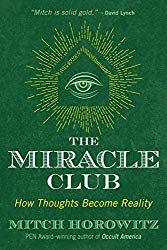

The Miracle Club: How Thoughts Become Reality, by Mitch Horowitz
Inner Traditions, 9781620557662, 192 pp., 2018
I was already a fan of Mitch Horowitz’s work when I picked up The Miracle Club. I finished reading his book Occult America (2009) recently, and I did notice he covered the New Thought movement extensively. It focuses on the schools of occult thought that influenced the birth of the United States as a nation. In The Miracle Club, he dives deep into the New Thought movement — tracing its roots, discussing its earliest proponents and practitioners, and its modern iterations that have huge implications for scientific breakthroughs.
New Thought is basically the late 19th century version of the “positive thinking” movement spawned by thinkers and writers including William James, Ralph Waldo Emerson, Napoleon Hill, Neville Goddard, and many others. Its most popular recent iteration was The Secret by Rhonda Byrne, which came out in 2006. The Secret was widely criticized for its basic tenet — the “law of attraction” or the idea that your thoughts create your reality. Readers and critics inferred that The Secret implied (and stated outright!) that people create their own misfortune, up to and including ill health.
The idea that all misfortune is caused by faulty thinking is hugely problematic, and the notions that negative thinking causes physical disease like cancer creates a model of personal responsibility that strikes most as victim-blaming. In The Miracle Club, Horowitz confronts this criticism, and acknowledges that this is where Byrne’s book failed. He goes further too, noting that New Thought’s major failure is its inability to grapple meaningfully with suffering — to approach what Horowitz calls a “theology of suffering.” Of course, many belief systems, ideologies, and religions also fail to land on a satisfying rationale for the purpose of suffering.
Horowitz makes a solid effort towards legitimizing New Thought, in part by acknowledging its “muscularity” or tenacity as a set of beliefs and principles that have proven to be durable over time and across cultures. He dedicated this book “To Working People Everywhere” (which I love!) and asserts that New Thought endures because people use it, whether or not it’s considered fashionable. The role of New Thought, and positive thinking have enormous traction within self-help rhetoric, because people respond to the principles and its use is widespread. New Thought is pervasive –particularly in a North American late capitalist, materialist context — but Horowitz also notes that positive thinking for individual betterment is an integral part of many religious practices.
He discusses how New Thought has been discredited in the popular press, noting recent dismissive treatment in prominent news media outlets (he cites publications including Newsweek, The New York Times and The Washington Post between 2014 and 2016) and a book by Barbara Ehrenreich titled Bright-Sided (2009). Horowitz points out that new thought, or positive thinking in general, has been conflated with a fatuous anti-intellectualism that belies its deep roots in our cultural stories about boot strapping and individualism, which necessarily rely on an ideology of personal development and “right thinking” with regard to success.
Despite popular and vocal advocates of positive thinking, including Oprah Winfrey, Deepak Chopra, and Tony Robbins, the movement has an outdated, unhip feel that lends it to dismissal. People think there is something asinine or inane about positive thinking. Horowitz notes with dismay that when it comes to thought experiments, critics seem more inclined to dismiss positive thought as being hokey or simplistic, rather than to engage with the practice to experiment with its potential.
The Miracle Club expounds on this potential. It starts with the implications of placebo research and the established benefits of prayer and positive outlook on health outcomes, and then delves much deeper into newer research with fascinating implications. Horowitz devotes a chapter to discussing this research, which amounts to multiple studies that are suggestive of the healing power of mindset. One interesting example discusses elderly subjects who were immersed in nostalgic settings evocative of their youth; they made gains in physical indicators of strength, flexibility, memory and cognitive function, even achieving increases in muscle mass.
In reviewing the literature, Horowitz notes a reticence to conclusively state that mindset has material consequences. He notes that even in the face of evidence, there is a reluctance to align the data with efficacy of New Thought principles that seem to be immensely polarizing. It is odd, considering the North American orientation towards individualism in both success and failure, that we would see a reticence to attribute results to thoughts. Of course, this highlights the other element of new thought that makes it unwieldy: it remains inexplicable.
Horowitz acquaints the reader with a wonderful New Thought icon with a discussion of the life and work of Neville Goddard, a little known early proponent of the power of thought. Goddard lived from 1905 to 1972, and the main thrust of his philosophy was not only that your thoughts create reality, but that (brace yourself!) your imagination is God. And he meant that quite literally. He wrote lots of books that are still widely available. (And which found their way onto my own “to be read” pile!) These explain exactly how you can use your divine imagination to create your own optimal reality, something he did time and again in his own life, as Horowitz documents. (Goddard is Horowitz’s own spiritual leader, and the podcasts I mention at the end of this piece reveal that Horowitz has a tattoo of Goddard on his bicep in tribute.)
Horowitz packs a lot into this book: a thorough history of the New Thought movement, introductions to its greater and lesser known champions, a thoughtful interrogation of where New Thought sits culturally (including discussion of research implications). But he also brings himself into the narrative, explaining how and why he came to New Thought and the role it plays in his life. In the end, the book is an invitation to the reader to engage with New Thought using techniques spelled out clearly by Horowitz.
The Miracle Club will appeal to anyone interested in self-help or the occult. The work has implications for people following almost any spiritual or occult path, and suggest that readers give serious consideration to how thoughts can help facilitate your progress towards your life goals. Horowitz removes the false dichotomy between rationality and intellectualism, and positive thinking, which optimally complement one another. But don’t take his word for it! Read this book, and join the Miracle Club yourself.
If you’re interested in learning more, I highly recommend two podcasts that were recently released featuring Mitch Horowitz discussing The Miracle Club — Jason Louv’s Ultraculture podcast (episode here) and Gordon White’s Rune Soup (episode here). Both made for excellent and thought-provoking listening.








